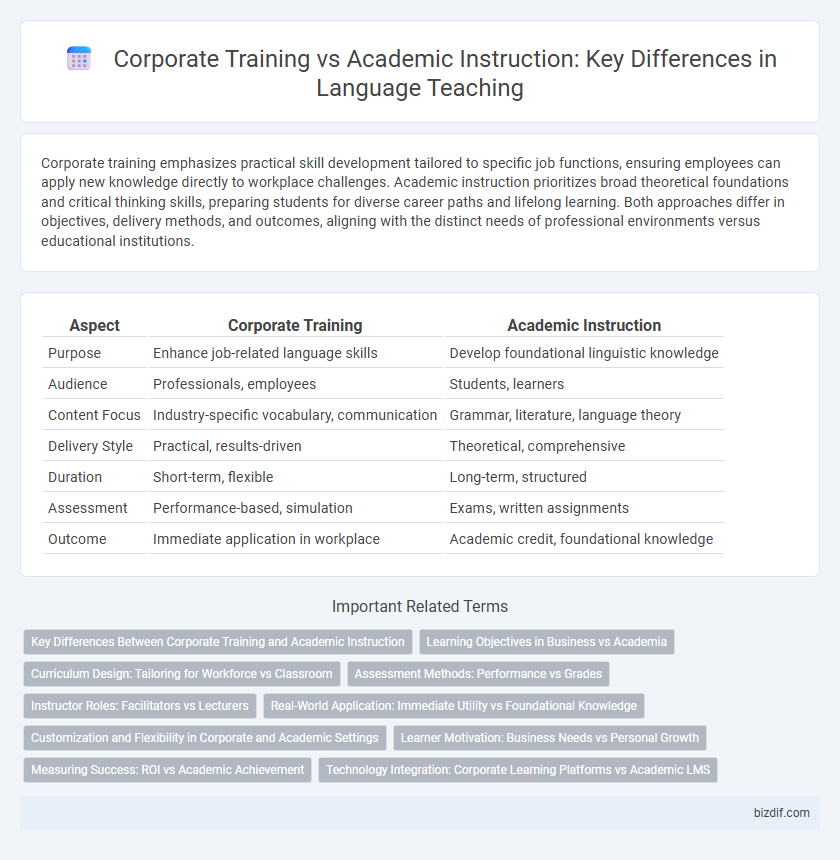Corporate training emphasizes practical skill development tailored to specific job functions, ensuring employees can apply new knowledge directly to workplace challenges. Academic instruction prioritizes broad theoretical foundations and critical thinking skills, preparing students for diverse career paths and lifelong learning. Both approaches differ in objectives, delivery methods, and outcomes, aligning with the distinct needs of professional environments versus educational institutions.
Table of Comparison
| Aspect | Corporate Training | Academic Instruction |
|---|---|---|
| Purpose | Enhance job-related language skills | Develop foundational linguistic knowledge |
| Audience | Professionals, employees | Students, learners |
| Content Focus | Industry-specific vocabulary, communication | Grammar, literature, language theory |
| Delivery Style | Practical, results-driven | Theoretical, comprehensive |
| Duration | Short-term, flexible | Long-term, structured |
| Assessment | Performance-based, simulation | Exams, written assignments |
| Outcome | Immediate application in workplace | Academic credit, foundational knowledge |
Key Differences Between Corporate Training and Academic Instruction
Corporate training centers on practical skill development tailored to specific job roles, emphasizing immediate application and measurable outcomes in the workplace. Academic instruction prioritizes theoretical knowledge, critical thinking, and broad intellectual foundations designed to support lifelong learning and research. Corporate programs are usually shorter, focused, and customizable, whereas academic courses follow structured curricula aimed at comprehensive education and credentialing.
Learning Objectives in Business vs Academia
Corporate training emphasizes practical learning objectives designed to enhance specific job-related skills and measurable performance outcomes within a business context. Academic instruction prioritizes theoretical knowledge acquisition, critical thinking, and comprehensive understanding aimed at long-term intellectual development. In business, learning objectives align closely with organizational goals, while academia focuses on foundational concepts and broad competencies.
Curriculum Design: Tailoring for Workforce vs Classroom
Corporate training curriculum design prioritizes practical, role-specific skills aligned with organizational goals, emphasizing real-world application and immediate impact on job performance. Academic instruction frameworks focus on theoretical knowledge and broad subject mastery, structured to develop critical thinking and foundational competence over time. Tailoring corporate programs involves agile updates to address evolving industry needs, whereas academic curricula follow standardized, time-tested educational models.
Assessment Methods: Performance vs Grades
Corporate training emphasizes performance-based assessments such as practical demonstrations, simulations, and real-world problem-solving exercises to measure skill acquisition and job readiness. Academic instruction typically relies on grades derived from standardized tests, quizzes, and assignments to evaluate theoretical understanding and knowledge retention. Performance assessments offer immediate feedback and align closely with workplace competencies, while grade-based evaluations prioritize academic mastery and comparative ranking.
Instructor Roles: Facilitators vs Lecturers
In corporate training, instructors act primarily as facilitators, guiding interactive sessions that encourage practical application and collaborative problem-solving. Academic instruction typically features lecturers who deliver structured content, focusing on theoretical knowledge and individual assessment. Facilitators engage learners through group activities and real-world scenarios, while lecturers emphasize knowledge transmission and subject mastery.
Real-World Application: Immediate Utility vs Foundational Knowledge
Corporate training emphasizes immediate utility by equipping employees with practical skills directly applicable to workplace tasks and challenges. Academic instruction prioritizes foundational knowledge that supports long-term intellectual development and adaptability across various contexts. This distinction ensures corporate learners quickly enhance job performance, while students build enduring analytical frameworks.
Customization and Flexibility in Corporate and Academic Settings
Corporate training emphasizes high customization and flexibility, tailoring content to specific business goals, employee roles, and real-time industry changes. Academic instruction follows a structured curriculum with limited adaptability, prioritizing comprehensive theoretical knowledge over immediate practical application. Corporate settings leverage modular, on-demand learning formats, while academic environments maintain fixed schedules and standardized assessments.
Learner Motivation: Business Needs vs Personal Growth
Corporate training prioritizes learner motivation driven by business needs, emphasizing skill acquisition that directly enhances job performance and organizational goals. Academic instruction, conversely, fosters motivation rooted in personal growth, encouraging critical thinking and intellectual development beyond immediate workplace applications. Understanding these distinct motivations helps tailor language instruction to effectively engage learners in either context.
Measuring Success: ROI vs Academic Achievement
Corporate training measures success primarily through return on investment (ROI), emphasizing improvements in employee performance, productivity, and business outcomes. Academic instruction evaluates success based on academic achievement, including grades, test scores, and mastery of curriculum standards. While corporate training prioritizes tangible financial benefits, academic programs focus on knowledge acquisition and cognitive development.
Technology Integration: Corporate Learning Platforms vs Academic LMS
Corporate training often utilizes advanced learning platforms such as SAP Litmos and Docebo, which emphasize real-time analytics, mobile accessibility, and integration with enterprise software to enhance employee skill development. Academic instruction typically relies on Learning Management Systems (LMS) like Moodle and Blackboard, designed to support curriculum delivery, assessment management, and collaborative learning in educational institutions. The distinction in technology integration reflects corporate needs for performance tracking and scalability versus academic goals centered on pedagogy and student engagement.
Corporate Training vs Academic Instruction Infographic

 bizdif.com
bizdif.com